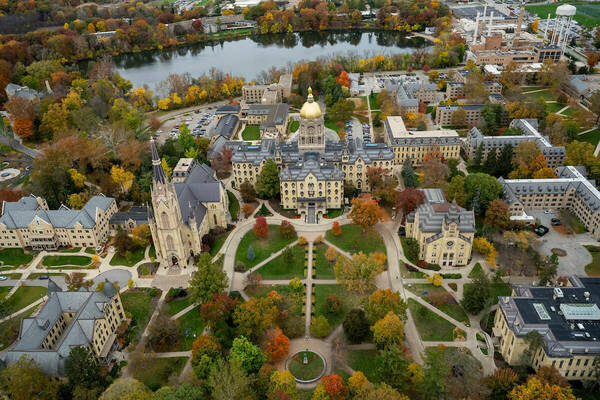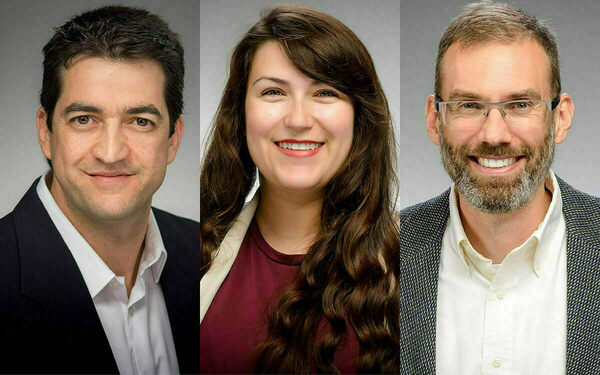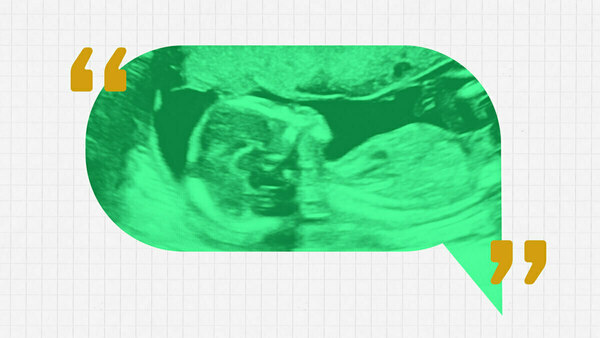Liam O’Connor selected as 2025 Richard H. Driehaus Prize Laureate at the University of Notre Dame; Philippe Rotthier wins Henry Hope Reed Award

Architect Liam O’Connor has been selected as the 2025 laureate of the Richard H. Driehaus Prize at the University of Notre Dame. The jury acknowledged his lifelong dedication to the design of a body of excellent new traditional public and private buildings and civic monuments — works projecting grace and beauty and expressing the shared emotions and cultural expectations of their audiences.
O’Connor’s war memorials, in particular, set his work apart for this year’s jury. The memorials are skillfully integrated into their urban or rural settings, with their landscape, fine art and construction details uniquely and thoughtfully developed in each case. Poetically charged, rationally disposed and emotionally laden, they are precisely sited, composed and constructed as statements of public admiration for the idea that freedom exists at all because of heroism and personal sacrifice for the common good, according to the jury citation.
The highest such integration of design, construction and symbolism is exemplified in his classical British Normandy Memorial that overlooks Gold Beach. The project is located adjacent to one of the five D-Day landing beaches during World War II. The memorial was inaugurated on June 6, 2021, 77 years after the 1944 landings, and commemorates the 22,442 British service personnel who sacrificed their lives there in the struggle to liberate Europe. The names of the fallen are carved into the structure’s 160 limestone Doric columns.

The Driehaus Prize citation states, “For this project, O’Connor orchestrated a masterplan for 60 acres of land and designed several structures to be eventually built from 3,500 tons of Burgundy limestone and hundreds of sustainably felled oak trees. Such was his commitment to this work that after its construction was halted during the coronavirus pandemic, he took on the task himself while directing 500 craftsmen and craftswomen.”
The citation continues, “Typical of O’Connor’s architecture is its enrichment by symbolic elements that add highly contemporary and personal dimensions to his interpretation of classicism. For the RAF Bomber Command Memorial in Hyde Park Corner in London, his reuse of riveted metal from downed aircraft to construct the central Doric pavilion’s roof memorializes the modern war machines central to these heroic aviators’ glory and demise.”
In addition, the citation noted “the merit of his private and commercial projects, where new construction blends into existing urban settings, in elegant and inventive designs that offer users and onlookers the gift of beautiful everyday places to be.”
Philippe Rotthier wins this year’s Henry Hope Reed Award
In conjunction with the Driehaus Prize, Philippe Rotthier was named the 2025 Henry Hope Reed Award laureate for his lifelong initiatives and continuing commitment to the cause of a new traditional architecture and urbanism. For more than 50 years he has dedicated his time and personal resources to resist the modernist disruption that followed WWII and lay the groundwork for reestablishing a culture of architectural continuity. Among his notable accomplishments was his renewal of vernacular architecture on the Island of Ibiza, Spain, where he built 80 houses using local materials and crafts.
The Philippe Rotthier Foundation, based in Brussels, Belgium, has provided the institutional framework for supporting this movement for architectural renewal through publications, exhibitions, occasional design competitions and his eponymous triennial architectural awards. His relentless advocacy for architectural change has enabled the emergence of two generations of significant young architects capable of exploring alternative forms of architectural modernity, including the 2025 Driehaus Prize laureate, Liam O’Connor.
Rotthier created the European Prize for the Reconstruction of the City that has been a catalyst for spreading the message of the intellectual, social and environmental merits of a contemporary classical and vernacular culture across the European continent. Since 1982, 86 award-winning works from 33 different countries have been awarded a Rotthier Prize.
Rotthier has been a significant contributor to the movement to rebuild existing and new communities and to steward nature in ways that have been proven to help humans flourish over thousands of years. The encouragement that he has provided to architects has begun to transform the practice of a new traditional architecture and urbanism worldwide at all scales, from repair through local design and craft, to new classical and vernacular architecture at the multi-block scale, to the urbanism of large-scale infill or city extension projects.
This year’s Driehaus Prize and Henry Hope Reed Award laureates were selected by a jury composed of Melissa DelVecchio, partner at Robert A.M. Stern Architects; Michael Lykoudis, professor of architecture at the University of Notre Dame; Léon Krier, architect and urbanist; Elizabeth Plater-Zyberk, founding principal of DPZ CoDesign and professor at the University of Miami; Demetri Porphyrios, principal of Porphyrios Associates, London; and Julia Treese, partner at Treese Architekten in Berlin and Munich. Stefanos Polyzoides, Notre Dame architecture professor and dean, and partner at Moule & Polyzoides, Architects and Urbanists, Pasadena, California, served as jury chair.
The $200,000 Driehaus Prize, the largest cash award in architecture worldwide, is granted by the Driehaus Trust in the name of Richard H. Driehaus, founder and chairman of Chicago-based Driehaus Capital Management LLC, as is the Henry Hope Reed Award of $50,000.
Contact: Carrie Gates, associate director of media relations, 574-993-9220, c.gates@nd.edu.
Latest Colleges & Schools
- Faculty receive prestigious early career awards from National Science FoundationDuring the 2024-25 academic year, four researchers in the University of Notre Dame’s Colleges of Engineering and Science received early-career awards from the National Science Foundation.
- ‘Prebunking’ false election claims may boost trust in electionsIn recent years, democracies worldwide have seen a growing erosion of trust in election outcomes and institutions, driven in part by fears of widespread fraud. New Notre Dame research finds that “prebunking” — providing accurate information before false claims spread — boosts trust in elections more effectively than traditional fact-checking.
- Justice Amy Coney Barrett to deliver Center for Citizenship and Constitutional Government lectureAmy Coney Barrett, associate justice of the Supreme Court of the United States, will speak at the University of Notre Dame at 4 p.m. Sept. 12 in the Leighton Concert Hall of the DeBartolo Performing Arts Center.
- Three Notre Dame researchers win NEH grants for humanities-based projectsDavid Hernandez, the Eli J. and Helen Shaheen Associate Professor of Classics, and Morgan Munsen, senior research and partnerships program manager at the Nanovic Institute for European Studies in the Keough School of Global Affairs, have each won an NEH Collaborative Research grant. Thomas A. Stapleford, associate professor in the Program of Liberal Studies, is leading a team that has been awarded a Humanities Research Center on Artificial Intelligence grant.
- Open-access database offers insights into U.S. congressional candidatesEach election cycle, thousands of candidates vie for seats in the U.S. House of Representatives and the Senate. Until now, there has been no comprehensive, publicly available resource cataloging what those candidates say about who they are or what they stand for. A new open-access database called CampaignView, created by researchers at the University of Notre Dame, offers researchers, journalists and educators a powerful tool to understand congressional elections.
- First impressions count: How babies are talked about during ultrasounds impacts parent perceptions, caregiving relationshipPsychologist Kaylin Hill studied the impact of a parent’s first impression of their baby during an ultrasound exam. The words used by the medical professional to describe the baby (positive or negative) influence how the parents perceive their baby, relate to them after they're born and even how that child behaves as a toddler. The research has broad implications for how we train medical professionals to interact with expectant parents, as well as how we care for parents during the perinatal period when they are most susceptible to depression.













